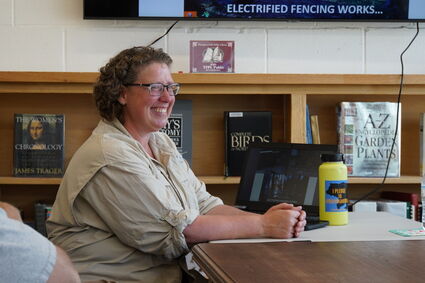FWP bear expert shares knowledge with residents
July 21, 2022

Annie Wooden
FWP bear management specialist Kim Annis has had a busy year with bears in Thompson Falls. Annis met with residents at the Thompson Falls Library last week.
Living in northwest Montana comes with the unique experience of living among bears. Humans and bears co-existing, as well as behaviors of both species, was the topic of a presentation last Wednesday by Kim Annis, Bear Management Specialist with Montana Fish, Wildlife & Parks (FWP). The event was held at the Thompson Falls Public Library and sponsored by the Thompson Falls Chamber of Commerce.
Annis spoke to community members with the goal of helping people understand what bears are doing and their behaviors. "Our goal is to decrease the unnecessary deaths of bears," said Annis, who has been with FWP for 15 years. Annis manages bears and mountain lions in Lincoln and Sanders counties and has had a busy year thus far in Thompson Falls. Wednesday before the presentation she was in the Copper King area outside Thompson Falls working to trap a sow and her cubs that were getting into a resident's bird feeders and hummingbird feeders. The property owner didn't remove the food source soon enough, causing the bears to hang around. Annis said they currently had three bear traps set in the Thompson Falls area attempting to capture and relocate bears that had conflicts with humans.
Annis told the group there are several things people can do to help prevent conflicts with bears. One of the primary problems is trash left outside, which makes an easy food source for bears. Annis said that 99.9% of conflicts between bears and people are food related. "I help people try to prevent those things from happening." Options available to residents include electrified fencing and bear-resistant trash cans, and if necessary, capturing and relocating bears. Relocation, however, is only a temporary tool. "If the attractant remains, bears will find it." She noted that for property owners who have chickens, FWP recommends using electric fencing. The same goes for fruit trees.
Annis encouraged residents to contact her at any time to help with bear issues. "Don't wait until a bear gets in your garbage, eats the bird feeder or destroys the beehives," she stressed. "It's never an if, it's a matter of when you'll have a bear conflict if you have food outside. Prevention is key. We don't want bears to learn that if they get near people, they will find food."
Preventing bear conflicts is a community effort, Annis said. "It's a choice and our choices affect our neighbors." She stated that in Big Sky, Montana, the community combined efforts and everyone is using bear-resistant trash cans. Whitefish is heading in the same direction, she said, adding that there are programs to help property owners with the costs of taking steps to prevent bear conflicts. Though no solution works 100% of the time, Annis encourages residents to do their part. "As long as we have people and bears, we will have conflicts," she explained. "We do what we can to prevent conflicts."
Annis also added that bears are active April 1 through December 1, and that they don't actually hibernate. They will enter a den and actually be awake, though groggy, and they maintain their core temperature for up to five-six months, living off the body fat they put on in the fall. She noted that the bears in northwest Montana have lower protein diets, so are smaller than bears found in places like Alaska. Male black bears locally average about 200 pounds, and male grizzlies about 400 pounds.
The presentation Wednesday also included an exercise to help people identify the difference between grizzly and black bears. Annis explained what people can do during surprise encounters with bears, and how to tell if the bear is behaving in a defensive manner or a predatory manner. One point she stressed is that a bear standing tall on two legs is not exhibiting defensive or predatory behavior, though that can be scary for a human to encounter. Annis encouraged people to carry bear spray at all times, and also to practice using it so they are ready in case of a bear encounter.
FWP has been working to establish a family tree of bears in the area through DNA collection. She showed a map of bear locations throughout the northwest and noted that unlike other carnivores, bears don't care about sharing space with other bears. "As a result, we can have a lot more bears on a landscape than other animals," Annis explained.
"We have a lot of black bears," Annis said Wednesday, noting that there is one bear in the Cabinet-Yaak ecosystem (which includes Sanders County) for every 1-1.5 square miles. The goal for this area is to have a distribution of females who are breeding, to limit human-caused mortality and to link bear populations. She said that ideally, the area would have around 100 grizzly bears. Currently there are about 60 in the Cabinet-Yaak ecosystem. She also added that when you have a small population of bears, "every death really impacts the population."
Though Annis has had a busy year, especially with conflict in Thompson Falls, she said she wants people to call her. "I'm glad people are asking for help," she noted. "No two people have the same needs."
For more information, contact Annis at (406) 291-1320.






Reader Comments(0)